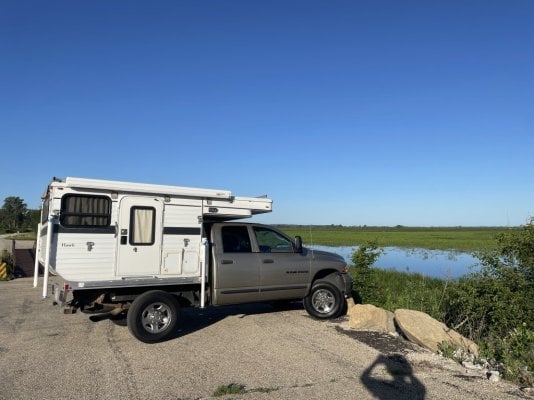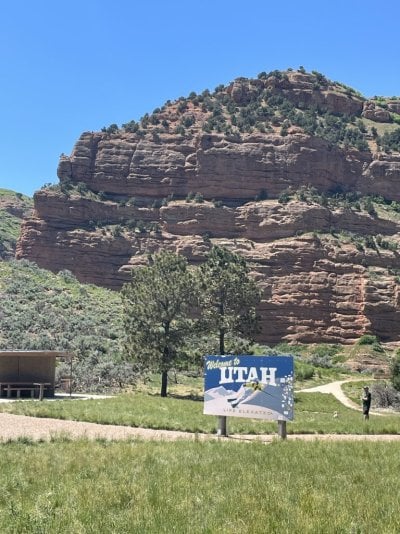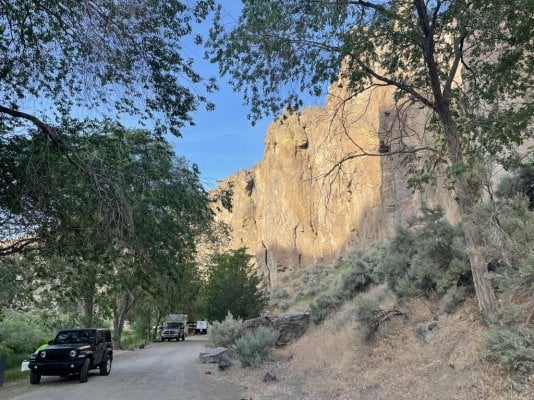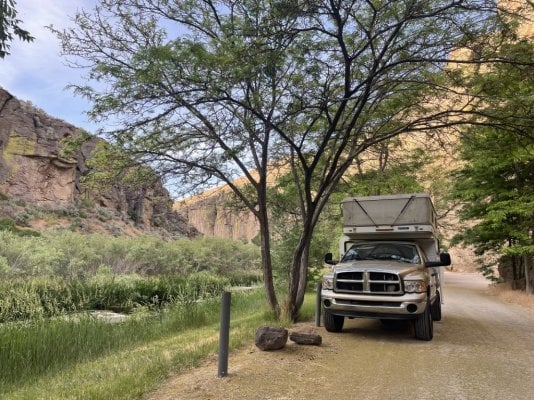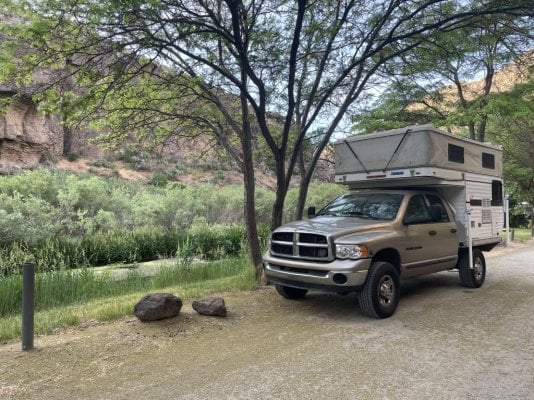I’m not sure where you’re located, but I stopped in at the Baker City DMV and picked up a trip permit for my travel trailer. You might try a walk in… I think it was $10.I have ordered the trip permit from the Oregon DMV. Just a little concerned that I might not get it in the mail before we leave (5 am Thurs 6/6) but perhaps there's a way to print it from the website.
You are using an out of date browser. It may not display this or other websites correctly.
You should upgrade or use an alternative browser.
You should upgrade or use an alternative browser.
Have I lost my mind?
- Thread starter Sagefemme
- Start date
Sagefemme
Advanced Member
I will ask the seller about this. What I know for sure is that they have only owned this rig since Feb 2024, and they acquired it in San Diego. They already had the truck and the flatbed (as they were looking for a flatbed FWC) so they drove the vehicle round trip to San Diego and back (to Missouri). And they state they have 7,000 miles total on the rig. Not sure how these numbers work out given the short time frame they have owned it. Also I'd like to know what service has been done on the truck since the Carfax reports stopped (when the original owner gave the truck to his grandson, who only had it 3 months and then sold to the current owner).Curious, what/when was the last trip the current owners took and how long time and miles wise? Did they have any issues, concerns on that trip?
Sagefemme
Advanced Member
I am in Eugene. I bought the trip permit (for $30, I think) online. I may walk in to the DMV here tomorrow and see if they can give me a copy.I’m not sure where you’re located, but I stopped in at the Baker City DMV and picked up a trip permit for my travel trailer. You might try a walk in… I think it was $10.
Andy Douglass
Senior Member
- Joined
- Jul 12, 2017
- Messages
- 221
When you get a FWC at the factory, you get a manual (and manuals for all the appliances) and someone on the staff spends the time to give you a thorough run through on all the important things NOT to do with your camper. Since you are dealing with an owner who has only had it for a short time, you might not get a good run through. Here are some basics that I can think of:
1. When opening (popping up) the lid, MAKE SURE ALL THE LATCHES ARE OPEN! There are usually 6 latches that hold the lid down when you travel (2 rear, 2 side, 2 front). Forgetting the side latches can let you fold the lid when you pop it up which is no good. Also, make sure the latches are all closed when travelling. It is a little embarrassing to pull over on the highway when you realize that the front of your camper has popped up at 60mph. I imagine its worse than embarrassing if you don't catch it in time and hit something with it.
2. Make sure the water heater has water in it before turning it on. You should be able to check that the water heater has water in it by turning the sink all the way to hot and having water come out. Better yet, familiarize yourself with the water heater and open the blow off valve on the external side of the water heater. If their is pressurized water in the water heater, you should get water out of the blow off when you hold it open. Firing a dry water heater can fry it if it doesn't have working failsafes.
3. If driving with jacks attached (not recommended, but probably necessary in your situation), never forget they are there, as they stick out quite a bit and are prone to getting caught on rocks, posts, gas pumps etcetera, which will damage the camper.
4. Pay attention to amperage when plugging in to shore power. There should be labels on your shore power inlet telling you what you can and can't do.
5. If you take the camper off the truck so the camper is freestanding on jacks, you are not supposed to go in the camper as the floor is not designed to hold weight when it is not supported underneath. Many people build a pedestal or dolly platform so they can go in and out without it being on the truck.
6. Your camper must be winterized if it will be in sub-freezing temperatures with no heat on. This is the process where you make sure there is no water in the system, which can freeze and break pipes.
7. The roof is weak, and not meant to support weight. Do not walk on it, or store anything that exceeds the weight rating (100 pounds if I remember right). Clear snow off it like your life depends on it.
Quirks:
If your FWC has a regular 120v outlet (like in your house), most likely it will only work when you are plugged into shore power.
Condensation is a big issue with any camper. In cold weather when you are running the furnace inside, you will want to check under the mattress periodically for condensation. It will form there because it is a very exposed area with two moist humans sleeping on it, and condensation that forms on the canvas sides will run down and collect there. My wife and I actually slept and cooked in our FWC for a full year while we were building our house. This included a brutal winter. We had the thermal pack insulation in the canvas pop up, but we actually had to remove it so condensation on the canvas could dry. We also had to keep the under mattress condensation in check. We had actual ice beneath our mattress many times. A FWC camper is not designed for the winter, but it can be done.
Unloading and loading the camper on the truck for the first time can be difficult, and you will bicker with your spouse. Do not try and rush it or force anything. Watch a video about it, but also know that every rig has a little different geometry.
1. When opening (popping up) the lid, MAKE SURE ALL THE LATCHES ARE OPEN! There are usually 6 latches that hold the lid down when you travel (2 rear, 2 side, 2 front). Forgetting the side latches can let you fold the lid when you pop it up which is no good. Also, make sure the latches are all closed when travelling. It is a little embarrassing to pull over on the highway when you realize that the front of your camper has popped up at 60mph. I imagine its worse than embarrassing if you don't catch it in time and hit something with it.
2. Make sure the water heater has water in it before turning it on. You should be able to check that the water heater has water in it by turning the sink all the way to hot and having water come out. Better yet, familiarize yourself with the water heater and open the blow off valve on the external side of the water heater. If their is pressurized water in the water heater, you should get water out of the blow off when you hold it open. Firing a dry water heater can fry it if it doesn't have working failsafes.
3. If driving with jacks attached (not recommended, but probably necessary in your situation), never forget they are there, as they stick out quite a bit and are prone to getting caught on rocks, posts, gas pumps etcetera, which will damage the camper.
4. Pay attention to amperage when plugging in to shore power. There should be labels on your shore power inlet telling you what you can and can't do.
5. If you take the camper off the truck so the camper is freestanding on jacks, you are not supposed to go in the camper as the floor is not designed to hold weight when it is not supported underneath. Many people build a pedestal or dolly platform so they can go in and out without it being on the truck.
6. Your camper must be winterized if it will be in sub-freezing temperatures with no heat on. This is the process where you make sure there is no water in the system, which can freeze and break pipes.
7. The roof is weak, and not meant to support weight. Do not walk on it, or store anything that exceeds the weight rating (100 pounds if I remember right). Clear snow off it like your life depends on it.
Quirks:
If your FWC has a regular 120v outlet (like in your house), most likely it will only work when you are plugged into shore power.
Condensation is a big issue with any camper. In cold weather when you are running the furnace inside, you will want to check under the mattress periodically for condensation. It will form there because it is a very exposed area with two moist humans sleeping on it, and condensation that forms on the canvas sides will run down and collect there. My wife and I actually slept and cooked in our FWC for a full year while we were building our house. This included a brutal winter. We had the thermal pack insulation in the canvas pop up, but we actually had to remove it so condensation on the canvas could dry. We also had to keep the under mattress condensation in check. We had actual ice beneath our mattress many times. A FWC camper is not designed for the winter, but it can be done.
Unloading and loading the camper on the truck for the first time can be difficult, and you will bicker with your spouse. Do not try and rush it or force anything. Watch a video about it, but also know that every rig has a little different geometry.
Andy, that is a great write up, thank you!
PaulT
Need gumbo
Better pin or copy to a startup folder if possible.
Paul
Paul
craig333
Riley's Human
If you have condensation it usually means you don't have enough ventilation. Best to open a vent low and one high. Not just a crack either.
Also, regarding what you plug your camper into, it is the Voltage, not current, that matters the most. As in, if you come upon an RV camping spot with 30 or 50A plugs, and have a dog-bone or other adapter, you can plug in your camper to it.... IF IT IS 120V nominal, not 220V. So, its the voltage not the current you need to be sure of. I carry testing tools, just to be sure.
tester
2nd tester
tester
2nd tester
Last edited:
Congratulations on the next phase of enjoying the out of doors! We are just north in Portland and have had our Tundra/Hawk since January 2020. Also birders and I do landscape photography. Gave up on 40 years of tent camping after spending 8 out of 10 days in a gloomy tent under pouring rain at Glacier in June 2019. We just got back today from two weeks near Steens and in the Ochocos (both with mosquitos!!).
Your first year will be a lot of fun and exploration with bouts of frustration and confusion. After that it gets more fun and less frustrating. There are a whole set of things you do with a pop-up that are kind of similar but not exactly the same as tent camping. You will do well.
PM me if you want to chat.
Tony
Your first year will be a lot of fun and exploration with bouts of frustration and confusion. After that it gets more fun and less frustrating. There are a whole set of things you do with a pop-up that are kind of similar but not exactly the same as tent camping. You will do well.
PM me if you want to chat.
Tony
@Sagefemme, all of us curious types keep looking for your update on the camper. I hope all went well with the purchase, and the trip home was smooth sailing.
Did I mention we love camper pictures? ?
Did I mention we love camper pictures? ?
Andy Douglass
Senior Member
- Joined
- Jul 12, 2017
- Messages
- 221
One thing I forgot: Watch your head. The short door on pop-up campers takes getting used to, and usually you will hit your head at least once before you learn how to get in and out. I always exit the camper backwards to keep my melon safe.
I placed a piece of foam pipe insulation on the inside frame edge.
Makes it softer if you do bump your head.
Always exit backwards it takes some getting used to but it
will come natural as time goes on.
Frank
Makes it softer if you do bump your head.
Always exit backwards it takes some getting used to but it
will come natural as time goes on.
Frank
craig333
Riley's Human
I exit both ways. I haven't hit my head in years.
pvstoy
Senior Member
If I wear a hat I'm doomed! And for protection from the sun I'm always wearing a hat. It is only a matter of time i'll get in a hurry and ... wham!I exit both ways. I haven't hit my head in years.
Piece of foam eases the pain.
Frank
Frank
Sagefemme
Advanced Member
Sagefemme
Advanced Member
Ok I think I posted one picture above (huge) of my husband (red shirt) and one of the sellers in the parking lot of what I think is Bass Pro WORLD Headquarters in Springfield Missouri. The transfer of the camper and truck was a little surreal--we flew to Springfield from Eugene and were picked up promptly by the wife of the couple selling the rig (in their regular car), and taken to Bass Pro World Headquarters, an amazing and overwhelming place if you ever get the chance.
We met the husband (with the camper) in the parking lot and they proceeded to show us how the camper works. They have not owned it long, but seemed to know it thoroughly. They are "van life" folks and seem to buy and sell campers and vans pretty regularly, and have built out from scratch a few vehicles themselves. They had a huge sheaf of paperwork that came with the camper (the person who they bought it from, who was the original owner, didn't say he had any papers but this couple discovered a whole big folder full of stuff when they were driving the camper to Missouri from California.
The truck also came with lots of documentation; the first owner (20 years) kept lots of records and maintained it well. Our sellers have been changing oil and oil filters themselves and he knew to the mile when the next oil change is due. He also gave us an unused fuel filter. He had stopped on his way to the meeting place to fill the tank. We just got home from our odyssey an hour ago and while emptying the truck found a fancy tire repair kit and pump that we didn't even know was in the vehicle.
After we signed all the papers and received our bills of sale and title on the truck she gave us a lovely goody basket with all manner of useful items: coffee mugs, gloves (they warned us diesel pumps are filthy), trail mix, ratcheting screwdriver, paracord, scissors, dishtowel, dish soap, zip ties, all in a lovely basket. Amazingly thoughtful. She said, "I knew you were driving a long way without much gear, so I tried to think of useful things." All in all an remarkably pleasant experience with the sellers who are clearly wonderful people--this was obvious after a short while spent with them.
We met the husband (with the camper) in the parking lot and they proceeded to show us how the camper works. They have not owned it long, but seemed to know it thoroughly. They are "van life" folks and seem to buy and sell campers and vans pretty regularly, and have built out from scratch a few vehicles themselves. They had a huge sheaf of paperwork that came with the camper (the person who they bought it from, who was the original owner, didn't say he had any papers but this couple discovered a whole big folder full of stuff when they were driving the camper to Missouri from California.
The truck also came with lots of documentation; the first owner (20 years) kept lots of records and maintained it well. Our sellers have been changing oil and oil filters themselves and he knew to the mile when the next oil change is due. He also gave us an unused fuel filter. He had stopped on his way to the meeting place to fill the tank. We just got home from our odyssey an hour ago and while emptying the truck found a fancy tire repair kit and pump that we didn't even know was in the vehicle.
After we signed all the papers and received our bills of sale and title on the truck she gave us a lovely goody basket with all manner of useful items: coffee mugs, gloves (they warned us diesel pumps are filthy), trail mix, ratcheting screwdriver, paracord, scissors, dishtowel, dish soap, zip ties, all in a lovely basket. Amazingly thoughtful. She said, "I knew you were driving a long way without much gear, so I tried to think of useful things." All in all an remarkably pleasant experience with the sellers who are clearly wonderful people--this was obvious after a short while spent with them.
Sagefemme
Advanced Member
Then we began, at 4:00 pm on Thursday, driving west! Between then and now (Sun evening) we drove 2,000 miles. We slept in two beautiful dispersed camping spots (one in Missouri and one in Idaho) and one RV park (in Wyoming). The rig drives like a dream; no sense of carrying a heavy load.
Attachments
Sagefemme
Advanced Member
We saw only one other FWC on this trip, and that was a guy (also driving a Hawk flatbed) who passed us going 75 on I-80 and who was gesticulating wildly that something was wrong up on our roof. I opened my window and tried not to drive off the road and he seemed to be saying something had flown off the roof. We pulled over, dreading what we might find, and found that our rear vent was open; nothing else seemed to be amiss. Closed the vent and continued down the road. Amateur mistake, I guess.
Sadly I discovered when when setting up at our site that evening that something is indeed wrong with the vent over the bed (vent only, no fan). When you try to raise the cover it goes up a little ways then falls back down. I will have to look at the mechanism and figure out if I need a part to fix it. Lesson learned!!! Always make sure both vents are closed!
But this brings up a question: how does one fix things on the roof when you can't really be up there?
Sadly I discovered when when setting up at our site that evening that something is indeed wrong with the vent over the bed (vent only, no fan). When you try to raise the cover it goes up a little ways then falls back down. I will have to look at the mechanism and figure out if I need a part to fix it. Lesson learned!!! Always make sure both vents are closed!
But this brings up a question: how does one fix things on the roof when you can't really be up there?
Andy Douglass
Senior Member
- Joined
- Jul 12, 2017
- Messages
- 221
I think I remember something like this happening to one of our vent fans on our 2018 Hawk when the vent was frozen shut with refrozen snow melt on the roof. I was really busy with a lot of things at the time so I can't remember what I did to fix it, but I vaguely remember plastic gears being misaligned. All I know is that the vent works fine now and I didn't buy a new one.We saw only one other FWC on this trip, and that was a guy (also driving a Hawk flatbed) who passed us going 75 on I-80 and who was gesticulating wildly that something was wrong up on our roof. I opened my window and tried not to drive off the road and he seemed to be saying something had flown off the roof. We pulled over, dreading what we might find, and found that our rear vent was open; nothing else seemed to be amiss. Closed the vent and continued down the road. Amateur mistake, I guess.
Sadly I discovered when when setting up at our site that evening that something is indeed wrong with the vent over the bed (vent only, no fan). When you try to raise the cover it goes up a little ways then falls back down. I will have to look at the mechanism and figure out if I need a part to fix it. Lesson learned!!! Always make sure both vents are closed!
But this brings up a question: how does one fix things on the roof when you can't really be up there?
As for working on the roof, a sturdy ladder and someone to hold the ladder steady lets you reach just about everything.
I remembered a few other common issues you might run into:
The control boards that the water heaters are manufactured with are junk and very prone to failing. There is a USA company (Dinosaur...I think?) that makes quality replacements. Very easy to replace once you have the new board.
The propane furnace has what is called a sail switch inside of it. This is a little flap that detects air pressure from the fan. The furnace will not fire if the sail switch doesn't tell the control board that the fan is pushing air. If you turn the furnace on, hear the fan go, but then the burner doesn't fire up, this is probably the issue. The sail switch is prone to having dust and hair get caught on it and preventing it from working. It is an easy fix once you know how to do it, open the outside cover, pull the switch out and clean it off. Lots of threads here talk about it, and there are plenty of youtube videos since it is a very common furnace in the RV world.
Similar threads
- kmcintyre
- Four Wheel Camper Discussions
- Replies: 7
- Views: 890
- Sagefemme
- Trucks, Truck Accessories & Mods
- Replies: 19
- Views: 477
New posts
-
-
-
-
-
The All Terrain Campers photo thread
- Latest: Casa Escarlata Robles Too
-
-
-
-
** SOLD ** 2019 FLEET Four Wheel camper, in mint condition. $25,000
- Latest: paola accusani
Try RV LIFE Pro Free for 7 Days
- New Ad-Free experience on this RV LIFE Community.
- Plan the best RV Safe travel with RV LIFE Trip Wizard.
- Navigate with our RV Safe GPS mobile app.
- and much more...


